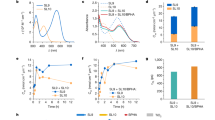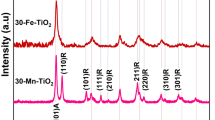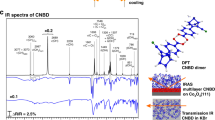Abstract
Although sequential adsorption of dyes in a single TiO2 electrode is ideal to extend the range of light absorption in dye-sensitized solar cells, high-temperature processing has so far limited its application. We report a method for selective positioning of organic dye molecules with different absorption ranges in a mesoporous TiO2 film by mimicking the concept of the stationary phase and the mobile phase in column chromatography, where polystyrene-filled mesoporous TiO2 film is explored for use as a stationary phase and a Brønsted-base-containing polymer solution is developed for use as a mobile phase for selective desorption of the adsorbed dye. By controlling the desorption and adsorption depth, yellow, red and green dyes were vertically aligned within a TiO2 film, which is confirmed by an electron probe micro-analyser. The external quantum efficiency (EQE) spectrum from a solar cell with three selectively positioned dyes reveals the EQE characteristics of each single-dye cell.
This is a preview of subscription content, access via your institution
Access options
Subscribe to this journal
Receive 12 print issues and online access
$259.00 per year
only $21.58 per issue
Buy this article
- Purchase on Springer Link
- Instant access to full article PDF
Prices may be subject to local taxes which are calculated during checkout






Similar content being viewed by others
References
Kohli, P. & Blanchard, G. J. Design and demonstration of hybrid multilayer structures: Layer-by-layer mixed covalent and ionic interlayer linking chemistry. Langmuir 16, 8518–8524 (2000).
Crespo-Biel, O. et al. Patterned, hybrid, multilayer nanostructures based on multivalent supramolecular interactions. Chem. Mater. 18, 2545–2551 (2006).
Isaacs, S. R., Choo, H., Ko, W. B. & Shon, Y. S. Chemical, thermal, and ultrasonic stability of hybrid nanoparticles and nanoparticle multilayer films. Chem. Mater. 18, 107–114 (2006).
Kang, E.-H. et al. Layer-by-layer deposited organic/inorganic hybrid multilayer films containing noncentrosymmetrically orientated azobenzene chromophores. Langmuir 23, 7594–7601 (2007).
Chui, S. S. Y., Lo, S. M. F., Charmant, J. P. H., Orpen, A. G. & Williams, I. D. A chemically functionalizable nanoporous material [Cu-3(TMA)(2)(H2O)(3)](n). Science 283, 1148–1150 (1999).
Pan, L. et al. RPM-1: A recyclable nanoporous material suitable for ship-in-bottle synthesis and large hydrocarbon sorption. Angew. Chem. Int. Ed. Engl. 42, 542–546 (2003).
Han, S. J., Sohn, K. & Hyeon, T. Fabrication of new nanoporous carbons through silica templates and their application to the adsorption of bulky dyes. Chem. Mater. 12, 3337–3341 (2000).
Zhao, X. B. et al. Hysteretic adsorption and desorption of hydrogen by nanoporous metal-organic frameworks. Science 306, 1012–1015 (2004).
Guillou, N. et al. Nickel(II) phosphate VSB-5: A magnetic nanoporous hydrogenation catalyst with 24-ring tunnels. Angew. Chem. Int. Ed. Engl. 40, 2831–2834 (2001).
Qi, D. F. et al. Optical emission of conjugated polymers adsorbed to nanoporous alumina. Nano Lett. 3, 1265–1268 (2003).
Oregan, B. & Gratzel, M. A low-cost, high-efficiency solar-cell based on dye-sensitized colloidal TiO2 films. Nature 353, 737–740 (1991).
Bach, U. et al. Solid-state dye-sensitized mesoporous TiO2 solar cells with high photon-to-electron conversion efficiencies. Nature 395, 583–585 (1998).
Gratzel, M. Photoelectrochemical cells. Nature 414, 338–344 (2001).
Hatzor, A. et al. A metal-ion coordinated hybrid multilayer. Langmuir 16, 4420–4423 (2000).
Xu, X. R., Han, J. T. & Cho, K. Fabrication of a stable inorganic-organic hybrid multilayer film with uniform and dense inorganic nanoparticle deposition. Chem. Commun. 8, 966–967 (2003).
Zhang, M. N. et al. Electrostatic layer-by-layer assembled carbon nanotube multilayer film and its electrocatalytic activity for O2 reduction. Langmuir 20, 8781–8785 (2004).
Kuang, D. et al. Co-sensitization of organic dyes for efficient ionic liquid electrolyte-based dye-sensitized solar cells. Langmuir 23, 10906–10909 (2007).
Cid, J.-J. et al. Molecular cosensitization for efficient panchromatic dye-sensitized solar cells. Angew. Chem. Int. Ed. Engl. 46, 8358–8362 (2007).
Wei, M. D. et al. Highly efficient dye-sensitized solar cells composed of mesoporous titanium dioxide. J. Mater. Chem. 16, 1287–1293 (2006).
van de Lagemaat, J., Park, N.-G. & Frank, A. J. Influence of electrical potential distribution, charge transport, and recombination on the photopotential and photocurrent conversion efficiency of dye-sensitized nanocrystalline TiO2 solar cells: A study by electrical impedance and optical modulation techniques. J. Phys. Chem. B 104, 2044–2052 (2000).
Kern, R. et al. Modeling and interpretation of electrical impedance spectra of dye solar cells operated under open-circuit conditions. Electrochim. Acta 47, 4213–4225 (2002).
Fabregat-Santiagoa, F. et al. Influence of electrolyte in transport and recombination in dye-sensitized solar cells studied by impedance spectroscopy. Sol. Energy Mater. Sol. Cells 87, 117–131 (2005).
Wang, Q., Moser, J.-E. & Gratzel, M. Electrochemical impedance spectroscopic analysis of dye-sensitized solar cells. J. Phys. Chem. B 109, 14945–14953 (2005).
Adachi, M. et al. Determination of parameters of electron transport in dye-sensitized solar cells using electrochemical impedance spectroscopy. J. Phys. Chem. B 110, 13872–13880 (2006).
Koo, H.-J. et al. Size-dependent scattering efficiency in dye-sensitized solar cell. Inorg. Chim. Acta 361, 677–683 (2008).
Lee, G.-W., Park, S. W., Kim, K., Ko, M. J. & Park, N.-G. Effects of electron donors in organic sensitizers on spectral response, electrochemical and photovoltaic properties. Renewable Energy abstr. P-PV-062 (2008).
Acknowledgements
This work was supported by the Korea Institute of Science and Technology (KIST) internal project and the Ministry of Information and Economy (MIK) new and renewable energy project under contract 2006-N-PV12-P-05. The authors also acknowledge financial support from the Pioneer Research Program of the Korea Science and Engineering Foundation (KOSEF) under contract No. 2008-05103.
Author information
Authors and Affiliations
Contributions
K.L. and N.-G.P. planned the project and data analysis. K.L. and S.W.P. carried out experimental work (K.L.: selective positioning of dye molecules; S.W.P.: P5 dye synthesis). M.J.K. and K.K. carried out impedance analysis.
Corresponding author
Rights and permissions
About this article
Cite this article
Lee, K., Park, S., Ko, M. et al. Selective positioning of organic dyes in a mesoporous inorganic oxide film. Nature Mater 8, 665–671 (2009). https://doi.org/10.1038/nmat2475
Received:
Accepted:
Published:
Issue Date:
DOI: https://doi.org/10.1038/nmat2475
This article is cited by
-
Extending spectrum response of squaraine-sensitized solar cell by Förster resonance energy transfer
Journal of Solid State Electrochemistry (2017)
-
Fluorescent material concentration dependency: Förster resonance energy transfer in quasi-solid state DSSCs
Electronic Materials Letters (2017)
-
Tailoring of Energy Levels in D-π-A Organic Dyes via Fluorination of Acceptor Units for Efficient Dye-Sensitized Solar Cells
Scientific Reports (2015)
-
Reactively sputtered nickel nitride as electrocatalytic counter electrode for dye- and quantum dot-sensitized solar cells
Scientific Reports (2015)
-
Adsorption behavior of methylene blue on amine-functionalized ordered mesoporous alumina
Journal of Porous Materials (2015)



